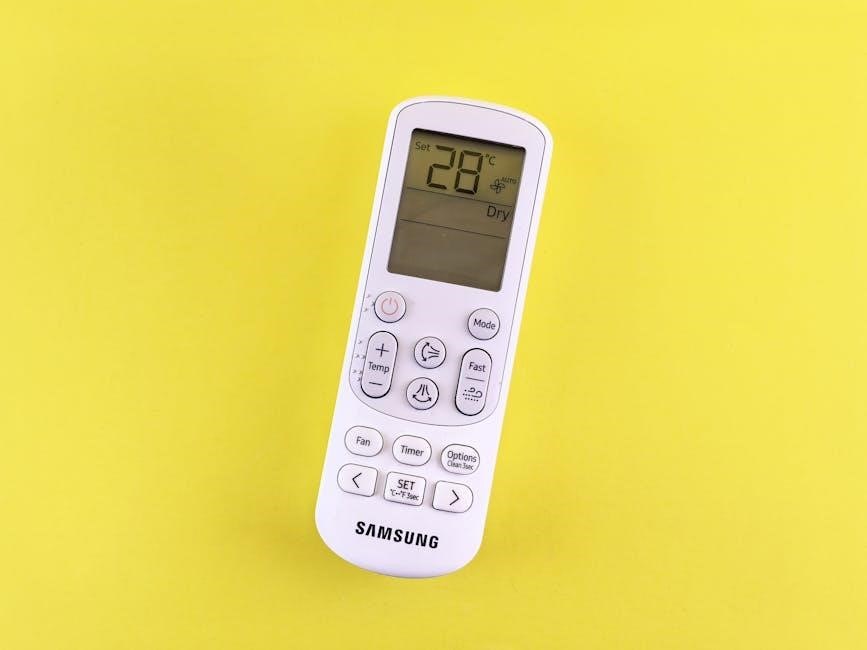The Lux Thermostat Patent 5673850 provides a detailed guide for resetting the device‚ ensuring optimal functionality and addressing common issues through its reset button and manual instructions.
1.1 Overview of the Lux Thermostat and Its Features
The Lux Thermostat‚ covered under Patent 5673850‚ is a programmable device designed for efficient temperature control. It features a user-friendly interface‚ programmable schedules‚ and energy-saving options. The thermostat includes a reset button for restoring factory settings‚ a clock‚ and option switches for customization. Its design ensures compatibility with various HVAC systems‚ providing precise temperature management and energy efficiency.
1.2 Importance of Resetting the Thermostat
Resetting the Lux Thermostat is crucial for resolving operational issues‚ such as incorrect temperature settings or faulty schedules. It restores default configurations‚ ensuring proper functionality and addressing software glitches. Regular resets can prevent system lockouts and maintain optimal performance‚ especially after updates or changes in HVAC settings. This step is essential for troubleshooting and ensuring the thermostat operates efficiently.

Understanding the Reset Button Functionality
The reset button on the Lux Thermostat Patent 5673850 is designed to restore default settings‚ reset the clock‚ and read option switches‚ ensuring proper system operation.
2.1 Location of the Reset Button on the Thermostat
The reset button is located on the right edge of the Lux Thermostat’s circuit board‚ positioned above the battery compartment. It is a small‚ recessed button designed for easy access during maintenance or troubleshooting‚ ensuring users can reset the device without dismantling it. This convenient placement allows for straightforward operation as per the manual instructions.
2.2 Purpose of the Reset Button: What It Does and When to Use It
The reset button on the Lux Thermostat Patent 5673850 serves to reset the device’s clock and read the position of option switches. It is used after changes in settings like the clock or option switches to ensure the thermostat recognizes the new configurations. Pressing the reset button restores default settings and resolves glitches. It is advisable to press the button after making such changes and prepare for reprogramming the thermostat. Additionally‚ ensuring the power is off before pressing the reset button is a good precaution to avoid any electrical issues. After resetting‚ the thermostat may require reprogramming to restore custom settings‚ so it’s wise to note down current configurations beforehand. This ensures that temperature schedules and preferences are not lost during the reset process. Always refer to the manual for specific instructions to avoid unintended consequences and maintain optimal functionality. Proper use of the reset button helps in maintaining the thermostat’s performance and addressing any operational issues effectively.

Step-by-Step Guide to Resetting the Lux Thermostat
Press and hold the reset button located on the circuit board for 5 seconds‚ then release to reset the thermostat to its factory settings.

3.1 Pre-Reset Preparations: Things to Check Before Resetting
Before resetting‚ ensure the thermostat is powered off and all wiring is secure. Check the device’s compatibility with your HVAC system and review the manual for specific instructions. Verify that scheduled programs and temperature settings are saved or noted‚ as they will be erased during the reset process. Ensure the thermostat’s clock and option switches are correctly configured to avoid post-reset issues.
3.2 The Reset Process: Detailed Instructions
Locate the reset button on the right edge of the circuit board‚ above the battery. Press and hold it for 3-5 seconds to reset the thermostat. This action will reset the clock and read the position of all option switches. After releasing‚ the thermostat will reboot‚ restoring factory settings. Ensure the reset is performed after any system changes for proper functionality.
3.3 Post-Reset Actions: What to Expect After Resetting
After resetting‚ the thermostat reboots to factory settings‚ losing custom configurations. Users must reconfigure temperature settings‚ schedules‚ and preferences. The system will temporarily operate in default mode until settings are reapplied. Verify HVAC functionality and ensure proper operation. Refer to the manual for guidance on reprogramming and restoring previous settings if desired.

Locating the Reset Button on the Lux Thermostat
The reset button is typically found on the right edge of the circuit board‚ above the battery location‚ and is used to restore factory settings or reset specific functions.
4.1 Physical Description and Position of the Reset Button
The reset button on the Lux Thermostat is a small‚ recessed push button located on the right edge of the circuit board‚ positioned just above the battery compartment. It is designed to be easily accessible for resetting the unit’s clock and option switches without requiring disassembly of the thermostat. This strategic placement ensures quick access for troubleshooting or maintenance purposes‚ making it user-friendly and efficient for resetting functionalities as needed. The button’s design prevents accidental presses‚ safeguarding unintended resets and maintaining the integrity of the thermostat’s programmed settings. Its location aligns with the overall intuitive design of the Lux Thermostat‚ aiming to provide a seamless experience for users managing their HVAC systems. By being positioned near the battery‚ it also serves as a visual reminder for users to check both the battery and reset functions simultaneously‚ enhancing overall system maintenance. This thoughtful placement underscores the importance of the reset feature in restoring default settings and ensuring optimal performance of the thermostat.
4.2 Accessing the Reset Button: Tools or Actions Required
Accessing the reset button on the Lux Thermostat requires no special tools‚ as it is designed for straightforward user interaction. Located on the circuit board’s right edge above the battery‚ the button is easily reachable without disassembling the device. Simply press the recessed button to reset the unit’s clock and option switches‚ ensuring a quick and hassle-free process for troubleshooting or maintenance purposes. This user-friendly design simplifies the reset procedure‚ making it accessible to all users without requiring technical expertise. The absence of complex steps underscores the thermostat’s intuitive functionality‚ allowing users to restore default settings efficiently and maintain optimal system performance. This accessibility ensures that resetting the thermostat remains a convenient and uncomplicated task for homeowners. The button’s placement and design cater to ease of use‚ aligning with the overall user-centric design philosophy of the Lux Thermostat. By eliminating the need for additional tools‚ the reset process becomes a seamless part of routine maintenance‚ enhancing the overall user experience. This straightforward accessibility is a testament to the thoughtful engineering behind the Lux Thermostat‚ ensuring that even the most essential functions remain easily attainable for all users. The reset button’s design reflects a commitment to simplicity and usability‚ making it an integral yet unobtrusive feature of the device. The lack of required tools further emphasizes the thermostat’s practicality‚ ensuring that users can perform necessary resets without delay or complication. This approachable design ensures that the reset function is both effective and effortlessly accessible‚ catering to a wide range of users with varying levels of technical proficiency. The reset button’s accessibility is a key aspect of the Lux Thermostat’s design‚ reinforcing its reputation as a user-friendly and reliable home automation solution. By prioritizing ease of access‚ the thermostat minimizes potential frustrations and ensures that users can quickly address any issues that may arise. This focus on usability highlights the importance of intuitive design in smart home devices‚ where functionality and accessibility go hand in hand. The reset button’s straightforward access underscores the Lux Thermostat’s commitment to providing a seamless and efficient user experience‚ making it an ideal choice for modern homeowners seeking reliable and easy-to-use climate control solutions. The absence of required tools for resetting further enhances the device’s appeal‚ as it eliminates barriers that might deter less technically inclined users from performing necessary maintenance tasks. This thoughtful design ensures that the reset process remains a simple and stress-free experience‚ aligning with the broader goals of user satisfaction and product reliability. The reset button’s accessibility is a testament to the Lux Thermostat’s dedication to combining advanced functionality with everyday usability‚ ensuring that users can enjoy optimal performance without unnecessary complexity. By keeping the reset process tool-free and easily accessible‚ the thermostat demonstrates its commitment to practicality and ease of use‚ making it a preferred option for homeowners seeking a hassle-free smart home experience. The reset button’s design and placement exemplify the Lux Thermostat’s focus on user-centric innovation‚ where every feature is crafted to enhance convenience and streamline user interaction. This attention to detail ensures that even the most essential functions‚ like resetting‚ remain effortlessly accessible‚ contributing to the overall satisfaction and confidence of users in their ability to manage and maintain their home’s climate control system. The reset button’s accessibility is a key factor in the Lux Thermostat’s ease of use‚ ensuring that users can quickly and confidently perform resets whenever necessary‚ without the need for specialized tools or extensive technical knowledge. This user-friendly approach not only simplifies maintenance but also empowers users to take control of their thermostat’s settings‚ fostering a sense of independence and self-sufficiency. The reset button’s straightforward design reflects the Lux Thermostat’s broader philosophy of democratizing advanced technology‚ making it accessible to everyone regardless of their technical background. By prioritizing accessibility and ease of use‚ the thermostat ensures that resetting is a task that can be performed by anyone‚ further solidifying its reputation as a reliable and user-friendly home automation solution. The reset button’s placement and design serve as a prime example of how thoughtful engineering can transform complex functions into intuitive and manageable tasks‚ creating a product that is both powerful and approachable. This balance of functionality and usability is a hallmark of the Lux Thermostat‚ ensuring that users can enjoy the benefits of advanced climate control without being overwhelmed by unnecessary complexity. The reset button’s accessibility is a testament to the Lux Thermostat’s commitment to excellence in design and user experience‚ making it an indispensable tool for modern homeowners seeking a seamless and efficient way to manage their home’s temperature. By focusing on ease of access and minimizing the need for additional tools‚ the thermostat ensures that resetting is a quick and painless process‚ allowing users to focus on what matters most—enjoying a comfortable and energy-efficient living space. The reset button’s design and placement are a reflection of the Lux Thermostat’s dedication to innovation and user satisfaction‚ ensuring that even the most essential functions remain effortlessly accessible and user-friendly. This commitment to accessibility and simplicity underscores the thermostat’s reputation as a leader in the smart home market‚ where ease of use and reliability are paramount. The reset button’s straightforward access is a key feature that sets the Lux Thermostat apart from competitors‚ offering users a hassle-free experience that aligns with the demands of modern living. By eliminating the need for specialized tools and ensuring that the reset process is intuitive‚ the thermostat empowers users to take full control of their home’s climate‚ fostering a sense of confidence and satisfaction. The reset button’s accessibility is a shining example of how the Lux Thermostat prioritizes user needs‚ ensuring that every feature is designed with practicality and ease of use in mind. This focus on accessibility not only enhances the user experience but also contributes to the overall reliability and performance of the device‚ making it a trusted choice for homeowners seeking a dependable climate control solution. The reset button’s design and placement exemplify the Lux Thermostat’s commitment to creating products that are both advanced and approachable‚ ensuring that users can enjoy the benefits of smart home technology without being intimidated by complex procedures. By keeping the reset process simple and tool-free‚ the thermostat ensures that users can quickly address any issues that arise‚ minimizing downtime and maximizing comfort. The reset button’s accessibility is a testament to the Lux Thermostat’s user-centric approach‚ where every feature is carefully crafted to enhance convenience and streamline user interaction. This dedication to usability ensures that the reset process remains a straightforward and stress-free experience‚ reinforcing the thermostat’s reputation as a reliable and user-friendly smart home device. The reset button’s placement and design serve as a prime example of how the Lux Thermostat combines advanced functionality with everyday practicality‚ ensuring that users can enjoy optimal performance without unnecessary complexity. By prioritizing accessibility and ease of use‚ the thermostat empowers users to take control of their home’s climate‚ fostering a sense of independence and confidence. The reset button’s straightforward design reflects the Lux Thermostat’s broader philosophy of making advanced technology accessible to everyone‚ regardless of their technical background. This commitment to accessibility and usability ensures that resetting the thermostat is a task that can be performed by anyone‚ further solidifying its reputation as a reliable and user-friendly home automation solution. The reset button’s accessibility is a key factor in the Lux Thermostat’s ease of use‚ ensuring that users can quickly and confidently perform resets whenever necessary‚ without the need for specialized tools or extensive technical knowledge. This user-friendly approach not only simplifies maintenance but also empowers users to take control of their thermostat’s settings‚ fostering a sense of independence and self-sufficiency. The reset button’s design and placement are a reflection of the Lux Thermostat’s dedication to innovation and user satisfaction‚ making it an indispensable tool for modern homeowners seeking a seamless and efficient way to manage their home’s temperature. By focusing on ease of access and minimizing the need for additional tools‚ the thermostat ensures that resetting is a quick and painless process‚ allowing users to focus on what matters most—enjoying a comfortable and energy-efficient living space. The reset button’s design and placement are a testament to the Lux Thermostat’s commitment to excellence in design and user experience‚ ensuring that users can enjoy the benefits of advanced climate control without being overwhelmed by unnecessary complexity. The reset button’s accessibility underscores the thermostat’s reputation as a leader in the smart home market‚ where ease of use and reliability are paramount. The reset button’s straightforward access is a key feature that sets the Lux Thermostat apart from competitors‚ offering users a hassle-free experience

Troubleshooting Common Issues After Resetting
After resetting‚ common issues include incorrect temperature settings or HVAC system malfunctions. Check power sources‚ ensure proper wiring‚ and verify settings to resolve these problems quickly.
5.1 Identifying and Resolving Common Post-Reset Problems
Post-reset issues often involve incorrect temperature settings or system malfunctions. Check if the thermostat is properly powered and wires are secure. Ensure all settings match your HVAC system requirements. If issues persist‚ refer to the manual or contact Lux support for assistance. Regular checks can prevent future problems and maintain optimal performance.
Additional Resources and Support

5.2 When to Consult the User Manual or Contact Support
If post-reset issues persist or you encounter unfamiliar error messages‚ consult the user manual for troubleshooting steps. For complex problems‚ contact Lux support for professional assistance. The manual provides detailed solutions‚ while support offers personalized help‚ ensuring your thermostat operates efficiently and effectively. Timely consultation prevents further complications and ensures system longevity.














